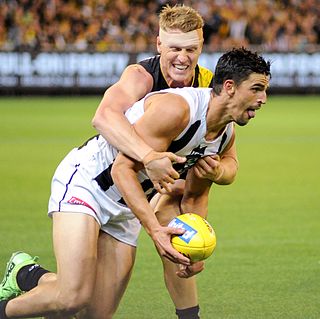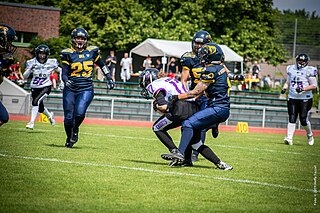Related Research Articles

College football is gridiron football consisting of American football played by teams of student athletes fielded by American universities, colleges, and military academies, or Canadian football played by teams of student athletes fielded by Canadian universities. It was through college football play that American football rules first gained popularity in the United States.

Most forms of football have a move known as a tackle. The primary and important purposes of tackling are to dispossess an opponent of the ball, to stop the player from gaining ground towards goal or to stop them from carrying out what they intend.

A touchdown is a scoring play in gridiron football. Whether running, passing, returning a kickoff or punt, or recovering a turnover, a team scores a touchdown by advancing the ball into the opponent's end zone.

Gridiron football, also known as North American football or, in North America, simply football, is a family of football team sports primarily played in the United States and Canada. American football, which uses 11-player teams, is the form played in the United States and the best known form of gridiron football worldwide, while Canadian football, featuring 12-player teams, predominates in Canada. Other derivative varieties include indoor football and Arena football, football for smaller teams, and informal games such as touch and flag football. Football is played at professional, collegiate, high school, semi-professional, and amateur levels.

In gridiron football, an onside kick is a kickoff deliberately kicked short in an attempt by the kicking team to regain possession of the ball. This is in contrast with a typical kickoff, in which the kicking team intends to give the ball to the other team and thus kicks the ball far downfield in order to maximize the distance the receiving team has to advance the ball in order to score. The risk to the team attempting an onside kick is that if it is unsuccessful and the receiving team gets the ball, the receiving team usually has a much better field position than it might have with a normal kickoff. Rules and procedures for onside kicks differ between the different codes and leagues of gridiron football.

American and Canadian football are gridiron codes of football that are very similar; both have their origins in rugby football, but some key differences exist.

Gameplay in American football consists of a series of downs, individual plays of short duration, outside of which the ball is dead or not in play. These can be plays from scrimmage – passes, runs, punts, or field goal attempts – or free kicks such as kickoffs and fair catch kicks. Substitutions can be made between downs, which allows for a great deal of specialization as coaches choose the players best suited for each particular situation. During a play, each team should have no more than 11 players on the field, and each of them has specific tasks assigned for that specific play.

The 1987 NFL season was the 68th regular season of the National Football League. This season featured games predominantly played by replacement players as the National Football League Players Association (NFLPA) players were on strike from weeks four to six. The season ended with Super Bowl XXII, with the Washington Redskins defeating the Denver Broncos 42–10 at Jack Murphy Stadium in San Diego. The Broncos suffered their second consecutive Super Bowl defeat.
The 1974 NFL season was the 55th regular season of the National Football League. The season ended with Super Bowl IX when the Pittsburgh Steelers defeated the Minnesota Vikings. Players held a strike from July 1 until August 10, prior to the regular season beginning; only one preseason game was canceled, and the preseason contests were held with all-rookie rosters.

A comparison of American football and rugby union is possible because of the games' shared origins, despite their dissimilarities.
High school football is gridiron football played by high school teams in the United States and Canada. It ranks among the most popular interscholastic sports in both countries, but its popularity is declining. According to the Washington Post, between 2009 and 2019, participation in high school football has declined by 9%.

A field goal (FG) is a means of scoring in gridiron football. To score a field goal, the team in possession of the ball must place kick, or drop kick, the ball through the goal, i.e., between the uprights and over the crossbar. American football requires that a field goal must only come during a play from scrimmage, while Canadian football retains open field kicks and thus field goals may be scored at any time from anywhere on the field and by any player. The vast majority of field goals, in both codes, are place kicked. Drop kicked field goals were common in the early days of gridiron football but are almost never done in modern times. In most leagues, a successful field goal awards three points.
The following terms are used in American football, both conventional and indoor. Some of these terms are also in use in Canadian football; for a list of terms unique to that code, see Glossary of Canadian football.

American football, referred to simply as football in the United States and Canada and also known as gridiron, is a team sport played by two teams of eleven players on a rectangular field with goalposts at each end. The offense, the team with possession of the oval-shaped football, attempts to advance down the field by running with the ball or passing it, while the defense, the team without possession of the ball, aims to stop the offense's advance and to take control of the ball for themselves. The offense must advance at least ten yards in four downs or plays; if they fail, they turn over the football to the defense, but if they succeed, they are given a new set of four downs to continue the drive. Points are scored primarily by advancing the ball into the opposing team's end zone for a touchdown or kicking the ball through the opponent's goalposts for a field goal. The team with the most points at the end of a game wins.

In gridiron football, a penalty is a sanction called against a team for a violation of the rules, called a foul. Officials initially signal penalties by tossing a bright yellow or orange colored penalty flag onto the field toward or at the spot of a foul. Many penalties result in moving the football toward the offending team's end zone, usually either 5, 10, or 15 yards, depending on the penalty. Most penalties against the defensive team also result in giving the offense an automatic first down, while a few penalties against the offensive team cause them to automatically lose a down. In some cases, depending on the spot of the foul, the ball is moved half the distance to the goal line rather than the usual number of yards, or the defense scores an automatic safety.

In gridiron football, a two-point conversion or two-point convert is a play a team attempts instead of kicking a one-point conversion immediately after it scores a touchdown. In a two-point conversion attempt, the team that just scored must run a play from scrimmage close to the opponent's goal line and advance the ball across the goal line in the same manner as if they were scoring a touchdown. If the team succeeds, it earns two additional points on top of the six points for the touchdown, for a total of eight points. If the team fails, no additional points are scored. In either case, if any time remains in the half, the team proceeds to a kickoff.
In gridiron football, a chop block is an attempt by an offensive player to cut block a defensive player while the defender is already engaged by another offensive player. The chop block is usually considered illegal and penalized by a loss of 15-yards due to the injury risk it presents to the defender.
In gridiron football, clipping is the act of a "throwing the body across the back of the leg of an eligible receiver or charging or falling into the back of an opponent below the waist after approaching him from behind, provided the opponent is not a runner." It is also clipping to roll up on the legs of an opponent after a block. It is usually illegal, but in the National Football League it is legal to clip above the knee in close-line play. The Canadian Football League has similar definitions, prohibitions and exceptions, including that "application of [a] penalty is determined by the initial contact".
References
- ↑ Hoerner, Earl. Safety in American football. p. 49.
- ↑ Bach, Greg; National Alliance for Youth Sports. Coaching Football for Dummies . John Wiley & Sons. p. 52.
Blocking below the waist.
- ↑ NCAA football rules and interpretations. pp. 104–05.
- ↑ Nelson, David. The anatomy of a game: football, the rules, and the men who made the game. p. 338.